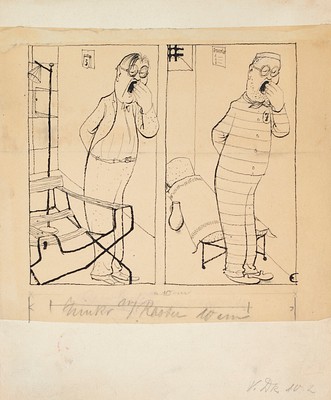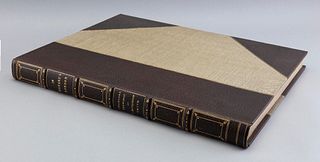Jean-François Laterrade Flore bordelaise ou description caractéristique des plantes qui croissent naturellement aux environs de Bordeaux, avec l'étymo
Two ways to bid:
- Leave a max absentee bid and the platform will bid on your behalf up to your maximum bid during the live auction.
- Bid live during the auction and your bids will be submitted real-time to the auctioneer.
Bid Increments
| Price | Bid Increment |
|---|---|
| EUR€0 | EUR€10 |
| EUR€100 | EUR€10 |
| EUR€200 | EUR€20 |
| EUR€300 | EUR€30 |
| EUR€420 | EUR€30 |
| EUR€480 | EUR€20 |
| EUR€500 | EUR€50 |
| EUR€2,000 | EUR€200 |
| EUR€3,200 | EUR€300 |
About Auction
Dec 14, 2021
Jeschke Jádi Auctions Berlin GmbH info@jvv-berlin.de
- Lot Description
Botanik
Laterrade, Jean-François
Flore bordelaise ou description caractéristique des plantes qui croissent naturellement aux environs de Bordeaux, avec l'étymologie, le site, l'époque de la floraison, etc., leurs propriétés et leurs principaux usages, précédée de notions élémentaires sur la botanique. Dédiée à M. le Comte de Lynch. Mit 15 Farbtafeln. Bordeaux, André Brossier, 1821. 516 S., 2 Bll., 15 Tafeln. 8°. HLdr. d. Zt. mit RSchild und RVergoldung (etwas fleckig und berieben, Rücken mit Einrissen).
2. Auflage. - Äußerst seltenes Exemplar mit den "Naturdruck"-Tafeln, die normalerweise fehlen. Nur ein weiteres Exemplar mit Tafeln bekannt (BNF, FRBNF30747317), die Kollation entspricht derjenigen der 1. Auflage. - Vorsatz mit ehem. hs. Besitzervermerk von René Guyot (1874-1970), membre fondateur de la société d'étude et de vulgarisation de la zoologie agricole. - Die Illustrationen stammen von Marcellin Eloi Bonnet in Zusammenarbeit mit seinem Sohn. Bonnet war Augenchirurg und Apotheker. Die Bonnets beteiligten sich an insgesamt drei Werken, die allesamt äußerst rar sind. Es handelt sich erstens um Nicaise Auguste Desvaux "Phyllographie, ou histoire naturelle des feuilles", welches 1809 erschien und von dem nur die ersten beiden Ausgaben mit 32 Tafeln erschienen. Das zweite Werk, ihr Meisterwerk, die "Facies plantarum", enthält eine Anzahl an Tafeln, die je nach Ausgabe variiert (von 45 bis zu mehr als 300 für das Exemplar von BnF). Und schließlich das vorliegende Werk. Die Drucktechnik wurde geheim gehalten, es scheint sich jedoch um einen Stichtiefdruck mit sorgfältiger Kolorierung der Blätter vor dem Druck zu handeln - eine Methode, die eigentlich vierzig Jahre später entwickelt wurde. "It seems very probable the Bonnets had developed a method by which they could etch a copy of a leaf on an intaglio plate, using a soft ground - or perhaps a method like the Autotypography process patented by George Wallis in 1860." (Cave, Impressions 73/74) - Braunfleckig.
Botany - With 15 colour plates. Cont. leather with spine label (somewhat stained and rubbed, spine with tears). - 2nd edition. - Extremely rare copy with the "nature print" plates, which are usually missing. Only one other copy with plates known (BNF, FRBNF30747317), the collation corresponds to that of the 1st edition. - Front endpaper with former handwritten owner's note by René Guyot (1874-1970), membre fondateur de la société d'étude et de vulgarisation de la zoologie agricole. - The illustrations are by Marcellin Eloi Bonnet in collaboration with his son. Bonnet was an ophthalmic surgeon and pharmacist. The Bonnets participated in a total of three works, all of which are extremely rare. The first is Nicaise Auguste Desvaux's "Phyllographie, ou histoire naturelle des feuilles", which appeared in 1809 and of which only the first two editions were published with 32 plates. The second work, their masterpiece, the "Facies plantarum", contains a number of plates that varies according to the edition (from 45 to more than 300 for the BnF copy). Bonnet was an ophthalmic surgeon and pharmacist. The Bonnets participated in a total of three works, all of which are extremely rare. The first is Nicaise Auguste Desvaux's "Phyllographie, ou histoire naturelle des feuilles", which appeared in 1809 and of which only the first two editions with 32 plates were published. The second work, their masterpiece, the "Facies plantarum", contains a number of plates that varies according to the edition (from 45 to more than 300 for the BnF copy). And finally the present work. The printing technique was kept secret, but it appears to be intaglio with careful colouring of the leaves before printing - a method actually developed forty years later. "It seems very probable the Bonnets had developed a method by which they could etch a copy of a leaf on an intaglio plate, using a soft ground - or perhaps a method like the Autotypography process patented by George Wallis in 1860" (Cave, Impressions 73/74) - Brown spotted. *
- Buyer's Premium



 EUR
EUR CAD
CAD AUD
AUD GBP
GBP MXN
MXN HKD
HKD CNY
CNY MYR
MYR SEK
SEK SGD
SGD CHF
CHF THB
THB














